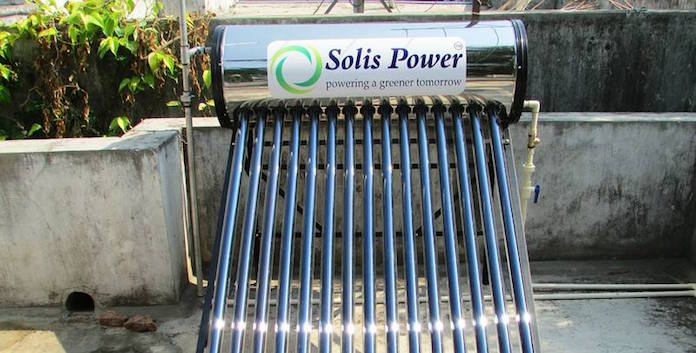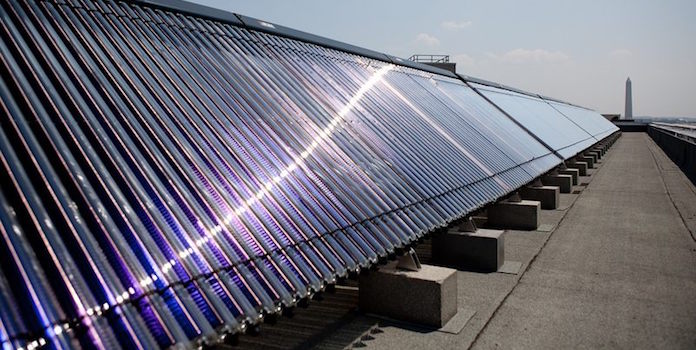How Much Does a Solar Water Heater Cost?

Compared to photovoltaics that could power a whole house, is installing a solar water heater still cost effective?
What does a solar water heater cost compared to solar panels? Why would you install a solar heater when solar panels can be seen as more useful? Let’s review water heaters as a whole from their inception, and then compare the cost to a photovoltaic installation.
In response to the energy crisis of the 1970s and ‘80s, solar water heaters (SWH) saw a boom in popularity, with sales peaking in 1984 at 180,000 systems (p. 15) installed nationwide. This popularity was spurred on by a 40% federal tax credit as well as numerous local incentives.
After the federal tax credit ended in 1984, SWH installations dropped significantly. In 2009, just 40,000 SWH were installed (the most since 1984), only 20% of the SWH’s golden years (p.16 of the report above).
Today, SWH’s main competition is photovoltaic (PV) solar – the solar panels you see on your neighbor’s roof, pumping out electricity to power their lights, fridge, heat, and even hot water if they’ve got an electric water heater.
PV solar is inexpensive, easy to install, and powers more than just your hot water. Considering all that, it begs the question: how much does it cost to install a solar water heater and, even more importantly, is it worth it?
Let’s walk through this step by step.
#1 What is a Solar Water Heater?
In a word, solar water heaters are energy-saving devices. Standard water heaters (like you probably have in your basement) use gas or electricity to serve two functions: First, they heat the water up to a nice, steamy temperature. Second, they keep it heated in their insulated tanks so you can take a warm and relaxing bath at any time of the day.
SWH save you money by performing the first of these functions – heating the water up – with sunlight, one of our more plentiful renewable resources. SWH systems do so in two different ways:
- Direct systems pump your actual water ‘directly’ into the solar collector on your roof, where it is heated up then pumped back into your home. Since water can freeze pretty easily, direct systems are great for mild climates where the temperature never goes below freezing.
- Indirect systems are better where freezing temperatures are a concern. Instead of pumping your water through the solar collectors, these systems pump antifreeze (yes like your car, but not as toxic) into the solar collectors, which then goes to your water tank and heats the water ‘indirectly’ through a heat exchanger.
#2 How is SWH different than photovoltaic solar panels?
While both SWH and PV solar save you money by decreasing your energy use, they go about it in very different ways.
As you’ve probably figured out by now, solar water heaters heat your water using the sun. This lets you avoid using costly electricity or gas to heat your water up, saving you money. PV solar, on the other hand, actually produces electricity, which you can use for your house’s appliances or sell to your electric utility through net metering.
Both SWH and PV solar necessitate solar panels on your roof. They might look similar from the ground, but they’re actually quite different. SWH collectors have small tubes filled with liquid that the sun heats up. PV solar panels are flat plates of solar-sensitive material that create electricity when hit with sunlight.
SWH decreases your energy use only through your water heater. PV solar decreases your electricity use in your entire household – refrigerator, air conditioning, lights, and any other electric gadgets – giving you the potential to save much more money over the long run (though PV solar is often more expensive to install, read the last section for more on SWH costs).
Components of a Solar Water Heater
SWH systems can be broken down into 3 main components: collectors (panels), storage, and balance of system (BOS) components.
1 – Collectors
Collectors are the panels on your roof that allow the liquid to heat up. There are a few different kinds of collectors, but flat plate collectors are common for residential applications. These are enclosed boxes on the roof. They’re flat black on the inside to encourage absorption of the sun’s heat, with an absorber plate on the inside bottom. Above that, there are pipes running lengthwise inside the box which contains the liquid – either water for direct SWH or antifreeze for indirect SHW – that heats up and is carried to the water tank.
2 – Storage
Just like a conventional water heater, your SWH needs a storage tank to house all that naturally-heated hot water! In fact, SWH systems typically need a backup water heating system for days when it’s cloudy or rainy. The backup system can be integrated into the SHW system or be separate. There are two different types of storage for SWH:
- One-tank system: After the water is heated, it is stored in a tank that serves double duty. It is the solar storage tank as well as the backup hot water tank.
- Two-tank system: Some installations have one tank for solar storage and separate conventional hot water tank. In this system, the solar-heated water flows from the SHW system into the conventional system, preheating the water.
3 – Balance of System
This is a strange name that just means all the other stuff you need to make your solar water heater work: pipes, nuts, bolts, brackets, and everything else.
Some SWH systems – known as active systems – have an electric pump that ‘actively’ pushes the liquid through the solar collector. Other systems, known as passive systems, rely on gravity to feed water into the solar collectors.
#3 How much does a Solar Water Heater cost?
According to a 2012 study by the National Renewable Energy Lab (p. xii), the average solar water heater costs between $6,000 and $10,000 (before incentives). This is quite high when compared to a conventional gas water heater’s $600 to $1,350.
As you can see, some SWH are much more expensive than others, mostly due to all the different available equipment and set-ups. For instance, indirect systems are easier and cheaper to install, but only work in a small portion of the US (mostly southern California and southern Florida).
Of course, this high cost isn’t the end of the story, as there are numerous incentives available for SWH, including the federal 30% tax credit. While this credit has mostly been touted for PV solar installations, SWH are also eligible! The tax credit is just that – a credit, not a deduction – and so is equal to a 30% discount on your total installation costs. Applying it to the average costs above, the total cost drops to a range between $4,200 to $7,000.
Depending on your area, your local city or utility might offer rebates, tax credits, or other incentives for solar water heaters as well. CPS Energy in Texas, for instance, offers rebates up to $2,000 for installing a solar water heater with your conventional water heater as backup. The Florida utility JEA offers a flat $400 rebate when you install an SWH system. Be sure to check with your city or utility to see what they offer.
#4 Are Solar Water Heaters worth the cost?
In the study mentioned above, NREL found that only 0.04% of the US population would be able to break even if they installed a $7,000 SWH system with a gas water heater backup (the majority of homes in the US have natural gas water heaters). If the price dropped to $2,500, about 50% of residents would be able to break even. If the cost dropped to just $1,000, 95% of the US population could break even (p.14).
(Just a note: by break even, we mean the point where the cost to install SWH is equal to the cost of purchasing natural gas to run a conventional water heater.)
Unless you’re eligible for some crazy-good incentives, ‘know a guy’ with extremely low SWH installation rates, or bathe a lot (ie, you use a lot of hot water), SWH probably doesn’t make financial sense.
As mentioned, NREL found that even if the price drops to $2,500, half the country still won’t make their money back on their initial investment. Now keep in mind that local incentives, water use, and electricity or gas prices all play a hand in how much you can save by installing a solar water heater, so it’s still a good idea to call a few installers and have a conversation about SWH in your area – but certainly don’t get your hopes up.
#5 Is there a better option?
Well, it’s funny you should ask. Solar water heaters might not be able to save you that much money, but PV solar certainly can!
While most SWH systems would be hard-pressed to simply break even, homeowners who install PV solar typically see payback in around 7 – 15 years depending on the location, financing, available incentives, and utility rates. If you live in North Carolina, for example, you’ll see a return on your investment after 13 years. Break even is 10 years in Arizona and just 9 years in San Diego. Once you’ve crossed that break-even point, you’ll be producing free, renewable energy for the remainder of your solar installation’s life – typically around 25 years.
With PV solar installations, savings range from a few thousand dollars to tens of thousands. Take San Diego, for instance. Southern California is perfect for solar, with its sunny weather all year long and high utility rates. If you purchase solar in cash, you could save over $36,000 over the life of an average-sized installation! In other areas of the country, savings can be lower, but certainly not non-existent (like some set-ups we know…).
If you’re thinking about installing solar, read up on Frequently Asked Questions about PV solar or even reach out to a few installers. If you’re still not sure about PV solar vs solar water heating, find a few installers that specialize in both and get their opinion. As mentioned, savings from SWH change from region to region, but if you can only choose one, then PV solar is probably the way to go.
Do you agree with us? Do you save money from your solar water heater? Let us know in the comments below!
Image Credits under CC License via Pixabay – 1, 2

